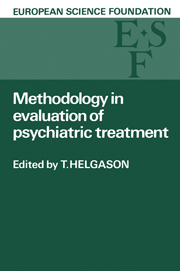 Methodology in Evaluation of Psychiatric Treatment
Methodology in Evaluation of Psychiatric Treatment from III - RATING METHODS IN EVALUATION OF TREATMENT
Introduction
The advent of community psychiatry in the last two decades has stimulated interest in measuring the outcome of psychiatric treatment not only in terms of absence of psychopathological symptoms but also in terms of the quality of life of the individual. Although a certain correlation between type and intensity of psychopathology on the one hand and social maladjustment on the other hand does not seem improbable, it has now been firmly established that they may also be independent of each other (Weissman et a/1974).
It seems inappropriate nowadays to look at the outcome of psychiatric illness merely in terms of symptoms and not also in terms of social functioning of the individual. How well do schizophrenic patients fare after the symptoms of the acute episode have receded and after they have been discharged from hospital? Do they work? Do they live in a family? Do they have friends? Can they care for themselves? Are their social relationships satisfying? These and similar questions are increasingly asked in follow-up studies and in many research centres efforts have been made to arrive at a standardized way of assessing what is usually called the social adjustment of a psychiatric patient.
Terminological and theoretical issues
On the most global level social adjustment can be defined as the equilibrium between an individual and his environment. More precisely it can be regarded as the functioning of an individual in specific social roles. Theoretically a discrepancy in this person-environment fit may result from a disability on the side of the individual or from disturbances in the social environment. Practically this equilibrium has to be regarded as a continuous dynamic process of an individual trying to cope with environmental demands either by adjusting to the environment, by actively changing the environment or his relation to it, or even by leaving his old environment and looking for a new one. Subjective psychological processes like denial may lead to a certain degree of social adjustment which could be judged by an outside observer as undesirable and even as a disguised form of social maladjustment.
It should be evident from these considerations that social adjustment is a complex process rather than a state and that there may be a number of pitfalls when efforts are made to measure it.
To save this book to your Kindle, first ensure [email protected] is added to your Approved Personal Document E-mail List under your Personal Document Settings on the Manage Your Content and Devices page of your Amazon account. Then enter the ‘name’ part of your Kindle email address below. Find out more about saving to your Kindle.
Note you can select to save to either the @free.kindle.com or @kindle.com variations. ‘@free.kindle.com’ emails are free but can only be saved to your device when it is connected to wi-fi. ‘@kindle.com’ emails can be delivered even when you are not connected to wi-fi, but note that service fees apply.
Find out more about the Kindle Personal Document Service.
To save content items to your account, please confirm that you agree to abide by our usage policies. If this is the first time you use this feature, you will be asked to authorise Cambridge Core to connect with your account. Find out more about saving content to Dropbox.
To save content items to your account, please confirm that you agree to abide by our usage policies. If this is the first time you use this feature, you will be asked to authorise Cambridge Core to connect with your account. Find out more about saving content to Google Drive.